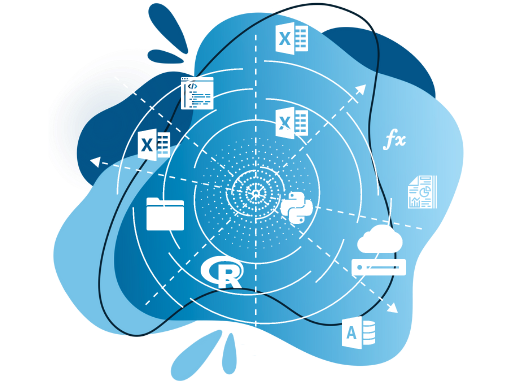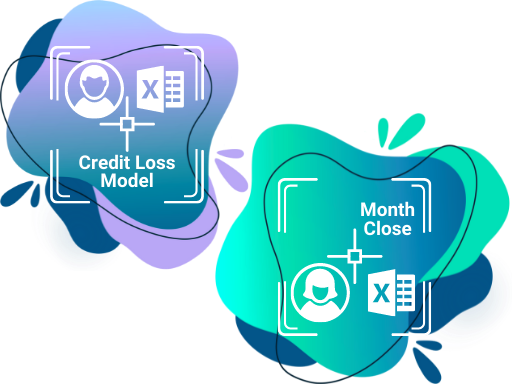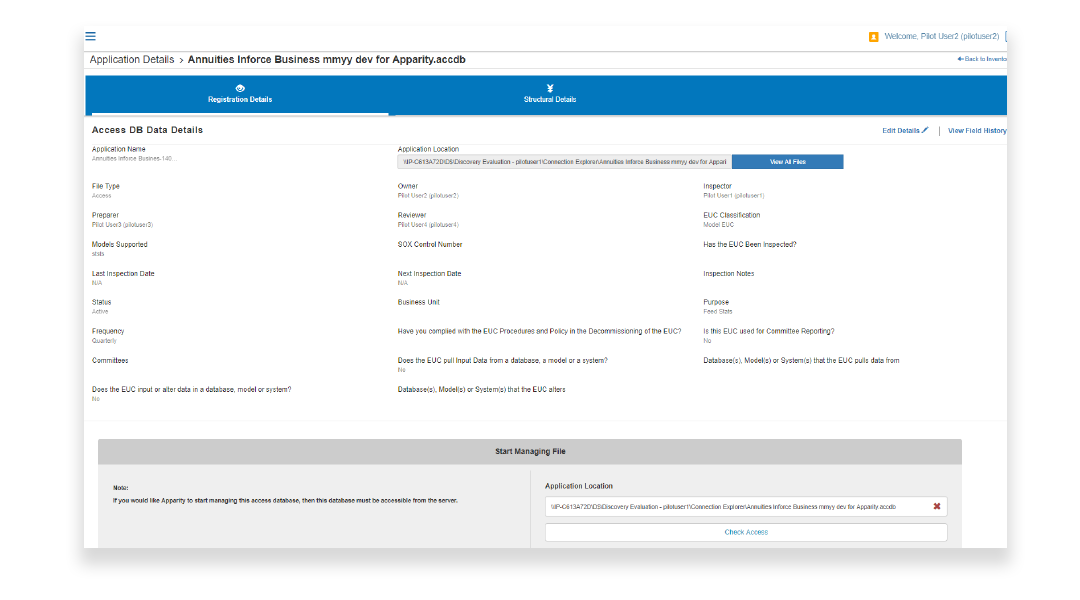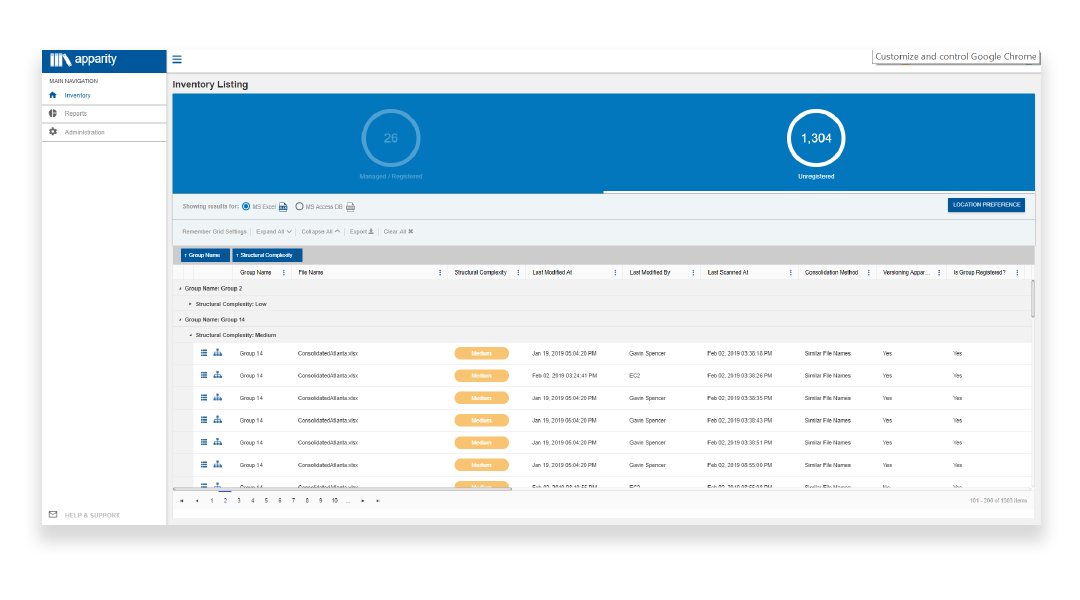EUC Identification
Apparity takes a dual approach to EUC identification with comprehensive discovery scanning & accurate point-of-use capture.
Comprehensive Approach to EUC Identification
Identifying end user computing (EUC) applications is crucial for the success of any EUC governance program. With Apparity, organizations can implement both a top-down and bottom-up approach. Both approaches work together in a streamlined way— eliminating duplication of efforts. Files identified through either method centrally flow to Apparity Inventory Management System (AIMS).
Discovery module provides a top-down approach by scanning and monitoring shared drives and file repositories. With robust scanning parameters, Discovery can detect a wide range of EUC application types across the file environment.
Active Capture provides a bottom-up targeted approach by analyzing spreadsheets at point of creation and modification. Active Capture intelligently monitors file usage and activity data to identify spreadsheet EUC applications.

Discovery Scanning
Our top-down approach to EUC identification provides consistent monitoring of shared drives and file repositories.
Discovery analyzes a file’s directory information, structural complexity and data lineage. Once identified as a potential EUC, users assess files against EUC policy requirements.
With Discovery’s power, organizations can focus on the areas where EUCs are most likely to be stored. Discovery can be managed by a central team, enabling an organized and methodical approach to EUC identification.
Discovery Scanning
Our top-down approach to EUC identification provides consistent monitoring of shared drives and file repositories.
Discovery analyzes a file’s directory information, structural complexity and data lineage. Once identified as a potential EUC, users assess files against EUC policy requirements.
With Discovery’s power, organizations can focus on the areas where EUCs are most likely to be stored. Discovery can be managed by a central team, enabling an organized and methodical approach to EUC identification.

Active Capture
Our bottom-up approach processes file data— usage, location and structural— to identify potential EUCs at the point of use. Active Capture analyzes every file opened in the Excel environment. Based on centrally defined parameters, certain files are flagged to the file user, requiring them to assess against EUC policy requirements.
Active Capture’s unique benefits include the ability to:
- Analyze any file being used, regardless of location
- Leverage usage data to accurately detect process-critical spreadsheets
- Decentralize the assessment process for a more seamless user experience

Central EUC Inventory
With other risk management software, inventory management is a siloed function in which discovery data has to be manually imported into inventory. Unlike competitors, Apparity Inventory Management System (AIMS) is integrated into our entire product suite and provides the ability to manage all your spreadsheet and EUC inventory regardless of stage (discovered, registered, managed).
Dual Approach Benefits
Working together, Discovery and Active Capture provide a comprehensive approach to EUC identification. Benefits include:
Reduced Noise
Apparity reduces the noise, or false positive results, associated with Discovery scanning in two ways.
- Configurable scan parameters:
Filter out files that don’t meet certain criteria. For example, filter out files without a processing component, not modified in the past x days, etc. - File copy grouping:
Group copies in one high-level view to be analyzed together. Receive greater insight into how a file is used while significantly reducing the burden of reviewing pages of Discovery scan results.
Single Pane of Glass
All scanned data is fed to the central Apparity Inventory Management System (AIMS), regardless of identification method. Likewise, file copies can be grouped together regardless of how they are identified— or where they are saved. Grouped files are presented in a user-friendly format without duplications.
Even files recognized as copies of previously identified versions are intelligently grouped together. Users will not be burdened to constantly assess files they’ve already dealt with.
Decentralized EUC Assessment
Both Discovery and Active Capture include customizable file assessments. Assessments are used to determine if the file needs to be managed per the organization’s EUC policy. Furthermore, the in-tool assessment utilizes a user-friendly workflow and a centralized audit trail of responses for compliance oversight.
After a file is identified, an assessor can be assigned multiple ways:
- Discovery: Pre-selected by the discovery scan initiator
- Active Capture: Automatically assigns to file users
- AIMS Unregistered inventory: Centrally assigned via AIMS
The assessor enters information into the assessment form to determine if the file is in or out-of-scope. Regardless of identification method, files considered within scope of the EUC policy can be monitored and managed. Apparity’s Registration and Active Management modules respectively handle these functions. Out-of-scope files have their assessment record retained centrally for auditing.
Reduction of Blind Spots
Apparity’s multiple approaches to identifying potential EUCs means fewer blind spots in your EUC governance program. Discovery, which can be configured to run on a regular cadence, scans files from known EUC locations.
But what is your central EUC team is unaware of certain file locations or encounter an encrypted file? Active Capture covers these scenarios, and more, by detecting those files once opened by a user.
Targeted Content Identification
Discovery can be configured to detect custom patterns during scans, which helps accurately target content of interest. Define a string or regular expression (regex) to identify content in cells and formulas.
Furthermore, string and regex patterns can be used to customize the structural complexity algorithm. The structural complexity algorithm determines file complexity (high/medium/low) based on the structural content of Excel files.






